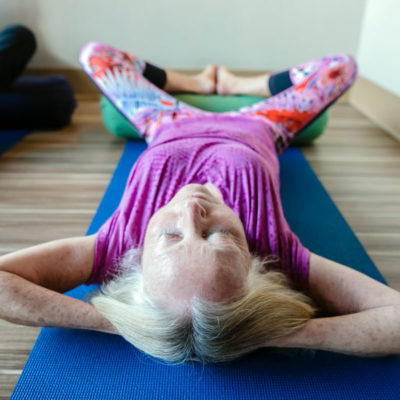Healing Gluteal Tendinopathy, aka Hip Pain
In this article, we’ll dive into a topic that might sound complex. It doesn’t have to be complicated. I’ve found the best way to address the body’s complexity with simple, doable shapes. What are gluteal tendinopathy’s symptoms and potential causes, and how can we alleviate this pain?
What is Gluteal Tendinopathy?
To start, let’s clarify what we’re dealing with. The glutes in the back of your hips are vital in stabilizing the pelvis, extending the hip, and supporting your ability to stand and walk. However, when addressing hip pain, we cannot focus on the muscles alone. The real issue lies deeper, even beyond the tendons connecting these muscles to the femur.
While tendonitis refers to inflammation of the tendon, tendinopathy suggests a deeper, more complex form of inflammation that begins to affect the muscle tissue. This results in a unique pain that signals something isn’t right in the hip area.
What Causes Gluteal Tendinopathy?
Many factors can contribute to gluteal tendinopathy, including overuse, underuse, improper biomechanics, or systemic issues like arthritis. Often, we look to strengthen and stretch surrounding muscles, but I have found consistent results in the Avita approach that uses doable, sustainable shapes to get to the cause and promote healing. By following our body’s sensations, we can uncover the root of the problem.
Healing Through Gentle Movement
Let’s get started with a couple of simple exercises you can do right from your chair. Please watch this free video, and I’ll talk you through it.
Exercise 1: Seated Forward Bend
- Cross One Leg Over the Other: Adjust your legs to improve the cross of the legs.
- Slowly Curve Forward: Bring your forehead toward your knee.
- Tune Into Your Body: What do you feel? Stiffness in the lower back? Tightness that longs for release?
As you let your arms hang and relax, focus on the sensation in your lower back. Remember, this isn’t about exercise; it’s about healing. Spend about 1.5 to 2 minutes in this shape, noticing how your hip joint responds. As you slowly curve forward, allow your muscles to release rather than stretch. Healing happens when we give our bodies the space and compression to unwind.
Exercise 2: Cross Ankle Over Knee
- Cross Your Ankle Over Your Knee: The same way you often sit in a chair with your foot supported on one knee.
- Curve Forward: Slowly moving closer to your foot, feeling the change in your hip.
- Release and Breathe: Let the pressure build gently without forcing the shape.
Feel the relationship between your foot, knee, and hip. This exercise helps create healing compression in the joint, promoting better function over time.
Transition to Wall
Now, let’s move to a wall for another approach.
- Legs Up the Wall: Find a spot on the floor with your hips 12 to 15 inches away from the wall. Support your head and feel your body adapt to the shape.
- Cross One Leg Over the Other: Similar to sitting, cross your right leg over the left and bend the left knee.
- Feel the Compression: Allow gentle pressure in the hip joint, which aids in healing. Spend another 1.5 to 2 minutes here.
Switch sides and repeat the process, paying close attention to any sensations.
The Importance of Patience
These exercises require patience and trust. You don’t need to force any movements or push through pain. The goal is to gently encourage your body to release tension and promote the healing process within.
Conclusion
Whether you’re dealing with gluteal tendinopathy, arthritis, or general hip discomfort, these simple movements can help. Incorporating them into your daily routine can lead to significant improvements over time.
Give yourself a moment each day for your joints and give them the pressure and care they crave.
Namaste,
Jeff




